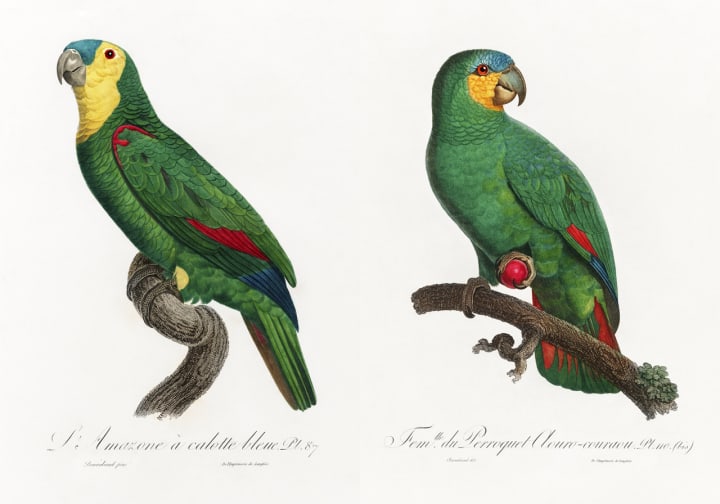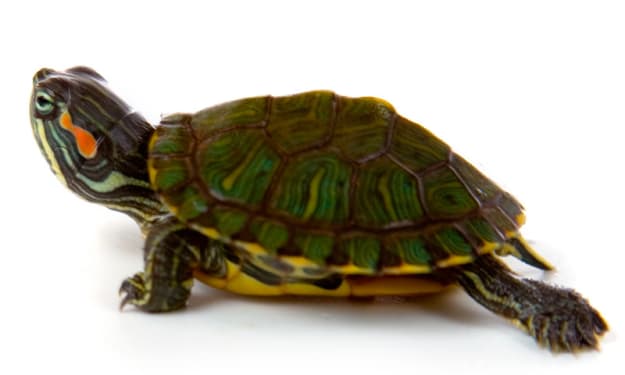Did A Yellow-Crowned Amazon Save a Lost Language?
They’re listening to everything you say

A while back, I was listening to an audiobook biography of the life of explorer and prolific writer/naturalist Alexander von Humboldt, and I came across a mention of his talking pet parrot of 30 years. As a parrot owner myself, I was left wanting to know more.
So I hopped on Google and stuck in the phrase, “Alexander von Humboldt parrot” and was quickly reminded of a famous story I first heard in the 1980s.
Did Humboldt meet a parrot who was the last speaker of a dead language?
A 2015 Mental Floss story, “The Parrot That Kept a Language Alive,” by Paul Anthony Jones, presents a good summary of the legend I heard all those years ago. During his Orinoco expedition, Humboldt encountered a village where one of the parrots spoke differently from the others. In Jones’s words:
“[T]his parrot…had belonged to a neighboring tribe, who had been the Caribs’ enemies. Ultimately, they had violently ejected them from their land…onto a tiny islet…There, the last of the tribe had died in total isolation several years earlier — taking with them their entire culture. This talking parrot was, consequently, the last creature alive who spoke their language.”
Apparently, there is a lot of room to quibble about the details. Alexander wasn’t the linguist in the family. That was his older brother Wilhelm, who did not accompany him into the wilds of the Orinoco.
But Alexander was a relentless scribbler, and one of the things he scribbled was a phonetic transcription of 40 of the parrot’s words into his notebook — the last record of a forgotten language.
I have no idea what his brother made of the tale.
Amazon parrots become a muse
Late last century, artist Rachel Berwick taught these words to two parrots — an Orange-winged Amazon and a Blue-fronted Amazon — who became performers in an art installation centered on lost languages that appeared in London’s Serpentine Gallery in 2000.
Later, she helped other museums train their own birds so they could set up similar installations. Now, the 40 words are being spoken by many other parrots.

We don’t seem to know for sure which parrot species spoke to Humboldt on the Orinoco. I immediately pictured a Yellow-crowned, because I’ve got one who is both talented and quite old, and they have awesome powers of mimicry for human voices, but her guesses are just as valid.
There is a choice of talented long-lived parrots in the area who might have preserved their favorite person’s language and voice long after their favorite human was gone.
Alexander von Humboldt’s pet parrot
As for Humboldt’s pet? Don’t think I’ve forgotten what sent me chasing down this rabbit hole in the first place. Someone online said she was a “gray vasa,” which I figured for their mishearing of Greater Vasa.
Sure enough. Put “Alexander von Humboldt Greater Vasa” into the search box, and what do you find?
Turns out the mounted remains of his pet parrot now belong to the Museum of Natural History in Berlin — or at least they did as of 2008. “Jacob” turns out to have been a female Greater Vasa Parrot.

Considering the bird’s name, I’m not sure if Humboldt ever figured out the bird was female, although with what we know today about the species, it isn’t too tough to tell. Females are larger and, in the breeding season, they go bald on the face to show off bright orange skin underneath.
They sing, they’re bossy, and they expect to be attended by two or even more males at the nest. These are not shy birds.
Vocal by nature, trios of Greater and Lesser Vasa Parrots were easily seen in the wild when I visited Madagascar in 2007.
Though rare in captivity, it doesn’t surprise me that they can learn to talk. In fact, I met a domestic-bred bird in the mid to late 1980s who was learning to speak English in a clear, sweet voice.
Author's Notes
I originally published this story on June 10, 2022. You may now enjoy it here without the paywall. While we're on the subject of writer, explorer, and gay icon Alexander von Humboldt, I've also published a review of his biography, The Invention of Nature, here:
Photo Credits
Featured Photo-- Yellow-crowned Amazon parrot: I took this photograph of my fiftysomething parrot and reserve all rights.
Center Photo-- Blue-front and Orange-wing Amazon parrots: Both images are from The Natural History of Parrots (1801–1805) by Francois Levaillant used under public domain license via rawpixel. The Blue front license is here, and the Orange-wing license is here.
Bottom Image-- Greater Vasa Parrot: The Natural History of Parrots (1801–1805) by Francois Levaillant, used under public domain license via rawpixel.
About the Creator
Amethyst Qu
Seeker, traveler, birder, crystal collector, photographer. I sometimes visit the mysterious side of life. Author of "The Moldavite Message" and "Crystal Magick, Meditation, and Manifestation."
https://linktr.ee/amethystqu






Comments
There are no comments for this story
Be the first to respond and start the conversation.